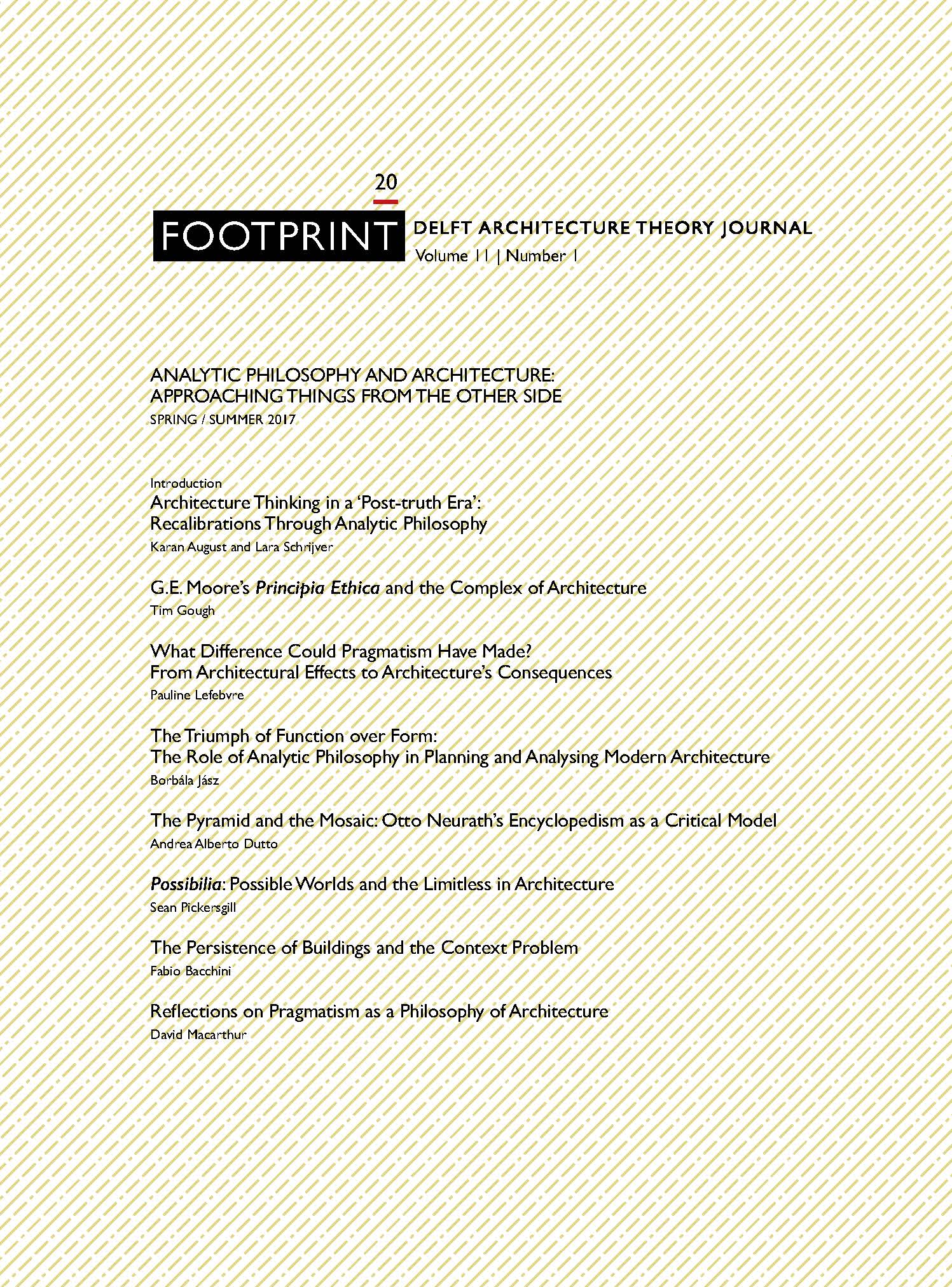The Pyramid and the Mosaic. Otto Neurath’s encyclopedism as a critical model
DOI:
https://doi.org/10.7480/footprint.11.1.1175Abstract
Otto Neurath, one of the founding members of the Vienna Circle, took up a firm opposition in relation to his colleagues. Instead of searching for an ideal language, he asserted the possibility of a ‘universal empiricist slang’, including both everyday and scientific language. Particularly, Neurath conceives of a comprehensive theory of a unified science that postulates the necessity of orchestration within the discursive procedures in science, inspired by the model of encyclopedism.
In the field of architecture, a similar encyclopedic endeavor was undertaken in Italy by Mario Ridolfi who, together with other leading exponents of architectural culture, conceived the Manuale dell’Architetto at the end of World War II. This construction handbook provided support to engineers during the intense period of post-war reconstruction. Unlike any previous attempt to document building culture, this collective work aspired to create a shared language able to cross the boundaries among the various fields of building science.
Finally, encyclopedism is considered as a possible ‘foundation’ for building design as a shared practice, with a specific focus on Ridolfi’s late research on the relation between traditional construction methods and housing design, in the countryside around Umbria.
References
Abbagnano, Nicola. “Norma.” Torino: UTET, 1990.
Barrera, Francesco, Carlo Guenzi, Emilio Pizzi, and Elena Tamagno. L’arte Di Edificare. Manuali in Italia 1750 - 1950. Edited by Carlo Guenzi. Milano: BE-MA Editrice, 1981.
Beauzée, Nicolas, and Jacuqes Philippe Douchet. “Grammar.” Translated by Julia Wallhager. The Encyclopedia of Diderot & d’Alembert (1757) Collaborative Translation Project. Ann Arbor: Michigan publishing, 2015.
Calcaprina, Cino, Aldo Cardelli, and Mario Fiorentino, eds. Manuale dell’architetto. Roma: C.N.R. - U.S.I.S., 1946.
Cellini, Francesco, and Claudio D’Amato. Mario Ridolfi : manuale delle tecniche tradizionali del costruire : il ciclo delle Marmore. Milano: Electa, 1997.
Cellini, Francesco, Claudio D’Amato, Wolfgang Frankl, and Mario Ridolfi. Le Architetture Di Ridolfi E Frankl. Milano: Electa, 2005.
D’Amato, Claudio, and Francesco Cellini. “La Palazzina Romana: Dall’organicismo Al Realismo.” In Le Architetture Di Ridolfi E Frankl, 50–59. Milano: Electa, 2005.
Durbiano, Giovanni. I Nuovi Maestri: Architetti Tra Politica E Cultura Nel Dopoguerra. Venezia: Marsilio, 2000.
Granger, Gilles Gaston. “Metodo.” Enciclopedia Einaudi. Torino: Einaudi, 1977.
Grassi, Giorgio. La costruzione logica dell’architettura (1967), 2008.
Guenzi, Carlo, Emilio Pizzi, and Alessandro Ubertazzi. “Manualistica e cultura tecnica.” Casabella, no. 439 (1978): 10–17.
Kruft, Hanno-Walter. A History of Architectural Theory : From Vitruvius to the Present. New York: Princeton Architectural Press, 1994.
Moravánszky, Ákos. Die Erneuerung Der Baukunst: Wege Zur Moderne in Mitteleuropa, 1900-1940. Salzburg: Residenz Verlag, 1988.
Moschini, Francesco. “Mario Ridolfi. L’architettura Come Pratica Artigianale.” d’Architettura, no. 17 (2002): 188–91.
Motta, Giancarlo, and Antonia Pizzigoni. I frammenti della città e gli elementi semplici dell’ architettura. Milano: CittàStudi, 1981.
Neurath, Otto. “Encyclopedias as ‘Model.’” In Philosophical Papers, 1913-1946, 145–58. Dordrecht: Reidel, n.d.
———. “Protocol Statements.” In Philosophical Papers, 1913-1946, 91–99. Dordrecht: Reidel, 1983.
———. “Radical Physicalism and the ‘Real World.’” In Philosophical Papers, 1913-1946, 100–114. Dordrecht: Reidel, 1983.
———. “Sociology in the Framework of Physicalism.” In Philosophical Papers, 1913-1946, 58–90. Dordrecht: Reidel, 1983.
———. “The Departmentalization of Unified Science.” In Philosophical Papers, 1913-1946, 200–205. Dordrecht: Reidel, 1983.
———. “The Orchestration of the Sciences by the Encyclopedism of Logical Empiricism.” Philosophy and Phenomenological Research 6, no. 4 (1946): 496–508.
———. “Unified Science as Encyclopedic Integration.” In International Encyclopedia of Unified Science, 1:1–27. Chicago: University of Chicago Press, 1946.
Nottelmann, Nikola. “Otto Neurath on the Structure of Protocol Sentences; A New Approach to an Interpretative Puzzle.” Journal for General Philosophy of Science 37, no. 1 (2006): 165–86.
Pagano, Giuseppe. Architettura Rurale Italiana. Milano: Hoepli, 1936.
Palma, Riccardo. “La casa malata: igiene e tecnologia nella costruzione della casa popolare.” In Cento Tavole. La casa a Milano dal 1890 - 1970, 39–43. Milano: Unicopli, 1997.
Portoghesi, Paolo. “Il Realismo Di Ridolfi.” In Mario Ridolfi Architetto 1904-2004, edited by Renato Nicolini. Milano: Electa, 2005.
Schilpp, Paul Arthur, ed. The Philosophy of Rudolf Carnap. 3. print. The Library of Living Philosophers 11. La Salle/Ill: Open Court, 1997.
Simondon, Gilbert. Du Mode D’ Existence Des Objets Techniques. Paris: Aubier- Montaigne, 1969.
Tafuri, Manfredo. “Architettura e Realismo.” In Architettura moderna : l’ avventura delle idee, 1750-1980, 122–45. Milano: Electa, 1985.
———. Storia Dell’ Architettura Italiana : 1944-1985. Torino: Einaudi, 1986.
Uebel, Thomas E. “Neurath’s Protocol Statements: A Naturalistic Theory of Data and Pragmatic Theory of Theory Acceptance.” Philosophy of Science 60, no. 4 (1993): 587–607.
Venturi, Franco. Le origini dell’Enciclopedia. Torino: Einaudi, 1963.
Vossoughian, Nader. Otto Neurath : The Language of the Global Polis. Rotterdam: NAi Publisher, 2008.
Zolo, Danilo. Scienza e politica in Otto Neurath: una prospettiva post-empiristica. Milano: Feltrinelli, 1986.
Downloads
Published
Issue
Section
License
- Authors retain copyright and grant the journal right of first publication with the work simultaneously licensed under a Creative Commons Attribution License that allows others to share the work with an acknowledgement of the work's authorship and initial publication in this journal.
- Authors are able to enter into separate, additional contractual arrangements for the non-exclusive distribution of the journal's published version of the work (e.g., post it to an institutional repository or publish it in a book), with an acknowledgement of its initial publication in this journal.





